Organic Food Needs More Land and Direct Energy to Be Produced Compared to Food from Conventional Farming: Empirical Evidence from the Czech Republic
Abstract
:1. Introduction
2. Materials and Methods
2.1. Data
2.2. Methods
- Cereals and oilseeds growing (FADN category 15);
- Fruit growing (FADN category 36);
- Milk production (FADN category 45);
- Cattle breeding (FADN categories 46,47,48).
- Index AP/ha = (organic AP/ha)/(conventional AP/ha)
- Index EC/ha = (organic EC/ha)/(conventional EC/ha)
- Index EC/AP = (organic EC/AP)/(conventional EC/AP)
3. Results
3.1. Agricultural Production
3.2. Energy Consumption
4. Discussion
5. Conclusions
Author Contributions
Funding
Institutional Review Board Statement
Data Availability Statement
Acknowledgments
Conflicts of Interest
Appendix A
| Organic | AP/ha | EC/ha | EC/AP | ||||||
|---|---|---|---|---|---|---|---|---|---|
| ANC | Non-ANC | Total | ANC | Non-ANC | Total | ANC | Non-ANC | Total | |
| 2001 | 213.85 | x | 215.86 | 37.42 | x | 37.62 | 0.14 | x | 0.14 |
| 2002 | 293.68 | 1419.75 | 312.98 | 35.46 | 171.03 | 37.79 | 0.11 | 0.11 | 0.11 |
| 2003 | 260.74 | 533.03 | 262.13 | 38.62 | 94.26 | 38.90 | 0.13 | 0.18 | 0.13 |
| 2004 | 319.22 | 587.58 | 442.17 | 50.52 | 86.96 | 58.55 | 0.13 | 0.13 | 0.12 |
| 2005 | 268.47 | 587.58 | 321.34 | 52.39 | 86.96 | 58.16 | 0.16 | 0.13 | 0.15 |
| 2006 | 309.78 | 204.76 | 307.20 | 67.46 | 39.58 | 66.78 | 0.19 | 0.18 | 0.19 |
| 2007 | 324.06 | 453.47 | 326.33 | 66.85 | 82.74 | 67.13 | 0.18 | 0.17 | 0.18 |
| 2008 | 329.00 | 1258.71 | 426.90 | 73.79 | 199.99 | 87.08 | 0.19 | 0.15 | 0.18 |
| 2009 | 387.71 | 709.42 | 427.47 | 76.90 | 114.97 | 81.52 | 0.17 | 0.15 | 0.17 |
| 2010 | 406.18 | 657.04 | 424.08 | 87.90 | 140.38 | 90.99 | 0.18 | 0.20 | 0.18 |
| 2011 | 364.04 | 543.36 | 379.32 | 92.05 | 96.29 | 92.51 | 0.21 | 0.16 | 0.21 |
| 2012 | 374.03 | 463.26 | 385.08 | 97.03 | 89.61 | 96.98 | 0.21 | 0.17 | 0.21 |
| 2013 | 430.50 | 463.26 | 433.30 | 103.89 | 89.61 | 102.66 | 0.21 | 0.17 | 0.21 |
| 2014 | 531.83 | 580.02 | 536.19 | 109.49 | 107.99 | 109.36 | 0.18 | 0.15 | 0.18 |
| 2015 | 497.18 | 454.02 | 491.35 | 97.81 | 68.12 | 93.80 | 0.17 | 0.10 | 0.16 |
| 2016 | 490.05 | 681.89 | 504.09 | 91.60 | 90.50 | 91.52 | 0.15 | 0.11 | 0.15 |
| 2017 | 505.09 | 840.70 | 540.86 | 99.46 | 86.05 | 99.58 | 0.16 | 0.01 | 0.08 |
| 2018 | 509.73 | 542.74 | 511.61 | 94.16 | 80.92 | 93.41 | 0.16 | 0.13 | 0.15 |
| 2019 | 468.44 | 518.15 | 446.07 | 97.44 | 77.51 | 90.84 | 0.17 | 0.11 | 0.17 |
| Conventional | AP/ha | EC/ha | EC/AP | ||||||
|---|---|---|---|---|---|---|---|---|---|
| ANC | Non-ANC | Total | ANC | Non-ANC | Total | ANC | Non-ANC | Total | |
| 2001 | 1196.90 | 1484.35 | 1294.74 | 102.23 | 120.31 | 108.38 | 0.08 | 0.07 | 0.07 |
| 2002 | 1195.06 | 1494.14 | 1291.29 | 93.29 | 106.96 | 97.69 | 0.07 | 0.07 | 0.07 |
| 2003 | 1039.59 | 1452.25 | 1192.54 | 91.79 | 108.26 | 97.89 | 0.08 | 0.07 | 0.08 |
| 2004 | 1173.69 | 1533.31 | 1371.70 | 104.04 | 117.98 | 111.72 | 0.08 | 0.07 | 0.07 |
| 2005 | 1088.84 | 1386.51 | 1277.62 | 117.70 | 77.29 | 91.41 | 0.10 | 0.18 | 0.13 |
| 2006 | 1331.97 | 1357.22 | 1358.12 | 129.30 | 150.49 | 120.84 | 0.09 | 0.16 | 0.11 |
| 2007 | 1240.92 | 1456.63 | 1399.09 | 139.31 | 150.18 | 147.28 | 0.11 | 0.10 | 0.10 |
| 2008 | 1198.13 | 1212.44 | 1441.24 | 152.05 | 150.43 | 164.23 | 0.12 | 0.11 | 0.11 |
| 2009 | 966.93 | 1467.06 | 1144.74 | 133.83 | 187.58 | 145.82 | 0.13 | 0.12 | 0.12 |
| 2010 | 1090.31 | 1467.06 | 1319.62 | 156.04 | 187.58 | 175.25 | 0.13 | 0.12 | 0.12 |
| 2011 | 1271.20 | 1867.96 | 1587.66 | 168.02 | 204.38 | 186.35 | 0.12 | 0.10 | 0.11 |
| 2012 | 1382.84 | 1828.51 | 1647.92 | 185.92 | 204.03 | 196.01 | 0.12 | 0.10 | 0.11 |
| 2013 | 1402.98 | 1828.51 | 1636.27 | 185.28 | 204.03 | 195.57 | 0.12 | 0.10 | 0.11 |
| 2014 | 1576.36 | 1850.86 | 1730.92 | 195.27 | 203.48 | 199.89 | 0.11 | 0.10 | 0.10 |
| 2015 | 1479.86 | 1857.10 | 1691.15 | 164.72 | 181.09 | 173.92 | 0.10 | 0.09 | 0.09 |
| 2016 | 1444.45 | 1901.88 | 1705.32 | 156.55 | 173.09 | 165.98 | 0.09 | 0.08 | 0.09 |
| 2017 | 1584.77 | 1780.46 | 1695.36 | 156.97 | 166.97 | 162.62 | 0.09 | 0.07 | 0.08 |
| 2018 | 1704.29 | 1870.37 | 1786.30 | 168.39 | 178.22 | 173.24 | 0.09 | 0.07 | 0.08 |
| 2019 | 1797.08 | 2091.96 | 1943.69 | 178.80 | 177.59 | 178.20 | 0.08 | 0.06 | 0.07 |
References
- Rizzo, G.; Borrello, M.; Guccione, G.D.; Schifani, G.; Cembalo, L. Organic Food Consumption: The Relevance of the Health Attribute. Sustainability 2020, 12, 595. [Google Scholar] [CrossRef] [Green Version]
- Rana, J.; Paul, J. Health motive and the purchase of organic food: A meta-analytic review. Int. J. Consum. Stud. 2020, 44, 162–171. [Google Scholar] [CrossRef]
- Wojciechowska-Solis, J.; Barska, A. Exploring the Preferences of Consumers’ Organic Products in Aspects of Sustainable Consumption: The Case of the Polish Consumer. Agriculture 2021, 11, 138. [Google Scholar] [CrossRef]
- Meemken, E.M.; Qaim, M. Organic agriculture, food security, and the environment. Annu. Rev. Resour. Econ. 2018, 10, 39–63. [Google Scholar] [CrossRef] [Green Version]
- Gomiero, T.; Pimentel, D.; Paoletti, M.G. Environmental impact of different agricultural management practices: Conventional vs. organic agriculture. Crit. Rev. Plant Sci. 2011, 30, 95–124. [Google Scholar] [CrossRef]
- Foley, J.A.; Ramankutty, N.; Brauman, K.A.; Cassidy, E.S.; Gerber, J.S.; Johnston, M.; Mueller, N.D.; O’Connell, C.; Ray, D.K.; West, P.C.; et al. Solutions for a cultivated planet. Nature 2011, 478, 337–342. [Google Scholar] [CrossRef] [PubMed] [Green Version]
- Seufert, V.; Ramankutty, N. Many shades of gray—The context-dependent performance of organic agriculture. Sci. Adv. 2017, 3, e1602638. [Google Scholar] [CrossRef] [Green Version]
- Mercati, V. Organic agriculture as a paradigm of sustainability: Italian food and its progression in the global market. Agric. Agric. Sci. Procedia 2016, 8, 798–802. [Google Scholar] [CrossRef] [Green Version]
- Sartaj, A.W.; Chand, S.; Najar, G.R.; Teli, M.A. Organic farming: As a climate change adaptation and mitigation strategy. Curr. Agric. Res. J. 2013, 1, 45. [Google Scholar]
- Reganold, J.P.; Wachter, J.M. Organic agriculture in the twenty-first century. Nat. Plants 2016, 2, 1–8. [Google Scholar] [CrossRef]
- Badgley, C.; Moghtader, J.; Quintero, E.; Zakem, E.; Chappell, M.J.; Aviles-Vazquez, K.; Samulon, A.; Perfecto, I. Organic agriculture and the global food supply. Renew. Agric. Food Syst. 2007, 22, 86–108. [Google Scholar] [CrossRef]
- Lotter, D. Facing food insecurity in Africa: Why, after 30 years of work in organic agriculture, I am promoting the use of synthetic fertilizers and herbicides in small-scale staple crop production. Agric. Hum. Values 2015, 32, 111–118. [Google Scholar] [CrossRef]
- Trewavas, A. Urban myths of organic farming. Nature 2001, 410, 409–410. [Google Scholar] [CrossRef]
- Redlichová, R.; Bečvářová, V.; Vinohradský, K. Vývoj Ekologického Zemědělství v ČR v Ekonomických Souvislostech, 1st ed.; Mendel University in Brno: Brno, Czech Republic, 2014; 92p, ISBN 978-80-7509-173-4. [Google Scholar]
- Qaim, M. Globalisation of agrifood systems and sustainable nutrition. Proc. Nutr. Soc. 2017, 76, 12–21. [Google Scholar] [CrossRef]
- Karkacier, O.; Goktolga, Z.G.; Cicek, A. A regression analysis of the effect of energy use in agriculture. Energy Policy 2006, 34, 3796–3800. [Google Scholar] [CrossRef]
- Moradi, M.; Nematollahi, M.A.; Khaneghah, A.M.; Pishgar-Komleh, S.H.; Rajabi, M.R. Comparison of energy consumption of wheat production in conservation and conventional agriculture using DEA. Environ. Sci. Pollut. Res. 2018, 25, 35200–35209. [Google Scholar] [CrossRef]
- Bashir, F. Energy Consumption and Agriculture Sector in Middle Income Developing Countries: A Panel Data Analysis. Pak. J. Soc. Sci. 2015, 35, 479–496. [Google Scholar]
- Zhang, L.; Pang, J.; Chen, X.; Lu, Z. Carbon emissions, energy consumption and economic growth: Evidence from the agricultural sector of China’s main grain-producing areas. Sci. Total Environ. 2019, 665, 1017–1025. [Google Scholar] [CrossRef] [PubMed]
- Todde, G.; Caria, M.; Gambella, F.; Pazzona, A. Energy and carbon impact of precision livestock farming technologies implementation in the milk chain: From dairy farm to cheese factory. Agriculture 2017, 7, 79. [Google Scholar] [CrossRef] [Green Version]
- FAO. The State of Food Security and Nutrition around the World in 2020. Available online: http://www.fao.org/3/ca9692en/online/ca9692en.html#chapter-1_1 (accessed on 30 April 2021).
- Hertel, T.W. The challenges of sustainably feeding a growing planet. Food Secur. 2015, 7, 185–198. [Google Scholar] [CrossRef]
- Kearney, J. Food consumption trends and drivers. Philos. Trans. R. Soc. B Biol. Sci. 2010, 365, 2793–2807. [Google Scholar] [CrossRef]
- Amundson, R.; Berhe, A.A.; Hopmans, J.W.; Olson, C.; Sztein, A.E.; Sparks, D.L. Soil science. Soil and human security in the 21st century. Science 2015, 348, 1261071. [Google Scholar] [CrossRef] [PubMed] [Green Version]
- Tuck, S.L.; Winqvist, C.; Mota, F.; Ahnström, J.; Turnbull, L.A.; Bengtsson, J. Land-use intensity and the effects of organic farming on biodiversity: A hierarchical meta-analysis. J. Appl. Ecol. 2014, 51, 746–755. [Google Scholar] [CrossRef]
- Seufert, V.; Ramankutty, N.; Foley, J.A. Comparing the yields of organic and conventional agriculture. Nature 2012, 485, 229–232. [Google Scholar] [CrossRef] [PubMed]
- Godfray, H.C.J.; Beddington, J.R.; Crute, I.R.; Haddad, L.; Lawrence, D.; Muir, J.F.; Pretty, J.; Robinson, S.; Thomas, S.M.; Toulmin, C. Food security: The challenge of feeding 9 billion people. Science 2010, 327, 812–818. [Google Scholar] [CrossRef] [Green Version]
- Connor, D.J. Organic agriculture cannot feed the world. Field Crop. Res. 2008, 106, 187. [Google Scholar] [CrossRef]
- Goulding, K.W.; Trewavas, A.J.; Giller, K.E. Can organic farming feed the world? A contribution to the debate on the ability of organic farming systems to provide sustainable supplies of food. In Proceedings-International Fertiliser Society; International Fertiliser Society: York, UK, 2009; Volume 663, pp. 1–27. ISSN 1466-1314. [Google Scholar]
- Ponisio, L.C.; M’Gonigle, L.K.; Mace, K.C.; Palomino, J.; De Valpine, P.; Kremen, C. Diversification practices reduce organic to conventional yield gap. Proc. R. Soc. B Biol. Sci. 2015, 282, 20141396. [Google Scholar] [CrossRef] [PubMed] [Green Version]
- Muller, A.; Schader, C.; El-Hage Scialabba, N.; Brüggemann, J.; Isensee, A.; Erb, K.H.; Smith, P.; Klocke, P.; Leiber, F.; Stolze, M.; et al. Strategies for feeding the world more sustainably with organic agriculture. Nat. Commun. 2017, 8, 1290. [Google Scholar] [CrossRef] [Green Version]
- Clark, M.; Tilman, D. Comparative analysis of environmental impacts of agricultural production systems, agricultural input efficiency, and food choice. Environ. Res. Lett. 2017, 12, 064016. [Google Scholar] [CrossRef]
- Tuomisto, H.L.; Hodge, I.D.; Riordan, P.; Macdonald, D.W. Does organic farming reduce environmental impacts?—A meta-analysis of European research. J. Environ. Manag. 2012, 112, 309–320. [Google Scholar] [CrossRef]
- Gomiero, T.; Paoletti, M.G.; Pimentel, D. Energy and environmental issues in organic and conventional agriculture. Crit. Rev. Plant Sci. 2008, 27, 239–254. [Google Scholar] [CrossRef]
- Ministry of Agriculture of the Czech Republic. Akční plán ČR pro Rozvoj Ekologického Zemědělství v Letech 2021–2027. Available online: https://pro-bio.cz/wp-content/uploads/2021/05/Akcni_plan_CR_pro_rozvoj_EZ_v_letech_2021_2027.pdf (accessed on 15 June 2021).
- Clapp, J. Food self-sufficiency: Making sense of it, and when it makes sense. Food Policy 2017, 66, 88–96. [Google Scholar] [CrossRef] [Green Version]
- Moghaddasi, R.; Pour, A.A. Energy consumption and total factor productivity growth in Iranian agriculture. Energy Rep. 2016, 2, 218–220. [Google Scholar] [CrossRef] [Green Version]
- Institute of Agricultural Economics and Information. Database FADN CZ. Available online: https://www.fadn.cz/fadnweb/index_e.html (accessed on 24 February 2021).
- European Commission—FADN. Definitions of Variables Used in FADN Standard Results. Available online: https://circabc.europa.eu/ui/group/880bbb5b-abc9-4c4c-9259-5c58867c27f5/library/162fb4de-22c9-489a-a0f6-8cd9f75de730 (accessed on 8 February 2021).
- Hlavsa, T.; Špicka, J.; Stolbova, M.; Hlouskova, Z. Statistical analysis of economic viability of farms operating in Czech areas facing natural constraints. Agric. Econ. 2020, 66, 193–202. [Google Scholar] [CrossRef]
- Dvouletý, O.; Blažková, I. Determinants of competitiveness of the Czech SMEs: Findings from the global competitiveness project. Compet. Rev. 2021, 31, 361–378. [Google Scholar] [CrossRef]
- Zdráhal, I.; Chmelíková, G.; Běčvářová, V. Ziskovost cukrovarnictví v Evropské unii. Listy Cukrov. Řepařské Odb. Časopis Obor Cukrovka-Cukr-Líh 2020, 136, 30–35. [Google Scholar]
- Latruffe, L.; Diazabakana, A.; Bockstaller, C.; Desjeux, Y.; Finn, J. Measurement of sustainability in agriculture: A review of indicators. Stud. Agric. Econ. 2016, 118, 123–130. [Google Scholar] [CrossRef]
- Slavickienė, A.; Savickienė, J. The Evaluation of Small and Medium Farms’ Economic Viability in the New EU Countries. Econ. Bus. J. 2014, 8, 843–855. [Google Scholar]
- Ryan, M.; Hennessy, T.; Buckley, C.; Dillon, E.J.; Donnellan, T.; Hanrahan, K.; Moran, B. Developing farm-level sustainability indicators for Ireland using the Teagasc National Farm Survey. Ir. J. Agric. Food Res. 2016, 55, 112–125. [Google Scholar] [CrossRef] [Green Version]
- Klima, K.; Kliszcz, A.; Puła, J.; Lepiarczyk, A. Yield and profitability of crop production in mountain less favoured areas. Agronomy 2020, 10, 700. [Google Scholar] [CrossRef]
- Lososová, J.; Zdenek, R.; Kopta, D. Development of the main production and economic indicators of Czech farms. Custos Agronegocio Line 2017, 13, 88–109. [Google Scholar]
- Ozkan, B.; Akcaoz, H.; Fert, C. Energy input–output analysis in Turkish agriculture. Renew. Energy 2004, 29, 39–51. [Google Scholar] [CrossRef]
- Gozgor, G.; Lau, C.K.M.; Lu, Z. Energy consumption and economic growth: New evidence from the OECD countries. Energy 2018, 153, 27–34. [Google Scholar] [CrossRef] [Green Version]
- Mader, P.; Fliebach, A.; Dubois, D.; Gunst, L.; Fried, P.; Niggli, U. Soil fertility and biodiversity in organic farming. Science 2002, 296, 1694–1697. [Google Scholar] [CrossRef] [Green Version]
- Carnol, M.; Chartin, C.; Krüger, I.; van Wesemael, B. Indicators of soil functioning in conventional, conservation and organic agriculture. In Proceedings of the EGU General Assembly Conference Abstracts, Online, 19–30 April 2021. EGU21-9489. [Google Scholar]
- Stein-Bachinger, K.; Gottwald, F.; Haub, A.; Schmidt, E. To what extent does organic farming promote species richness and abundance in temperate climates? A review. Org. Agric. 2021, 11, 1–12. [Google Scholar] [CrossRef] [Green Version]
- Štolbová, M.; Hlavsa, T.; Lekešová, M. Methods of calculating the handicaps of less favoured natural conditions. Agric. Econ. 2010, 56, 215–223. [Google Scholar] [CrossRef] [Green Version]
- Cork Declaration. The Cork Declaration—A Living Countryside. In Proceedings of the European Conference on Rural Development, Cork, Ireland, 7–9 November 1996; Available online: http://www.aughty.org/pdf/cork_declar.pdf (accessed on 6 March 2021).
- FAO. Why is Organic Food More Expensive than Conventional Food? Available online: http://www.fao.org/organicag/oa-faq/oa-faq5/en/ (accessed on 25 March 2021).
- Pilelienė, L.; Tamulienė, V. Consumer attitudes and behavior towards organic products: Evidence from the Lithuanian market. J. Entrep. Manag. Innov. 2021, 17, 269–299. [Google Scholar]
- Luiza-Maria, D. Economic and Social Effects of Organic Food Production and Consumption. In Annals of’Constantin Brancusi’University of Targu-Jiu. Economy Series; University of Targu-Jiu: Targu Jiu, Romania, 2021; Volume 1, pp. 156–162. [Google Scholar]
- Sirieix, L.; Kledal, P.R.; Sulitang, T. Organic food consumers’ trade-offs between local or imported, conventional or organic products: A qualitative study in Shanghai. Int. J. Consum. Stud. 2011, 35, 670–678. [Google Scholar] [CrossRef] [Green Version]
- Tilman, D.; Balzer, C.; Hill, J.; Befort, B.L. Global food demand and the sustainable intensification of agriculture. Proc. Natl. Acad. Sci. USA 2011, 108, 20260–20264. [Google Scholar] [CrossRef] [Green Version]
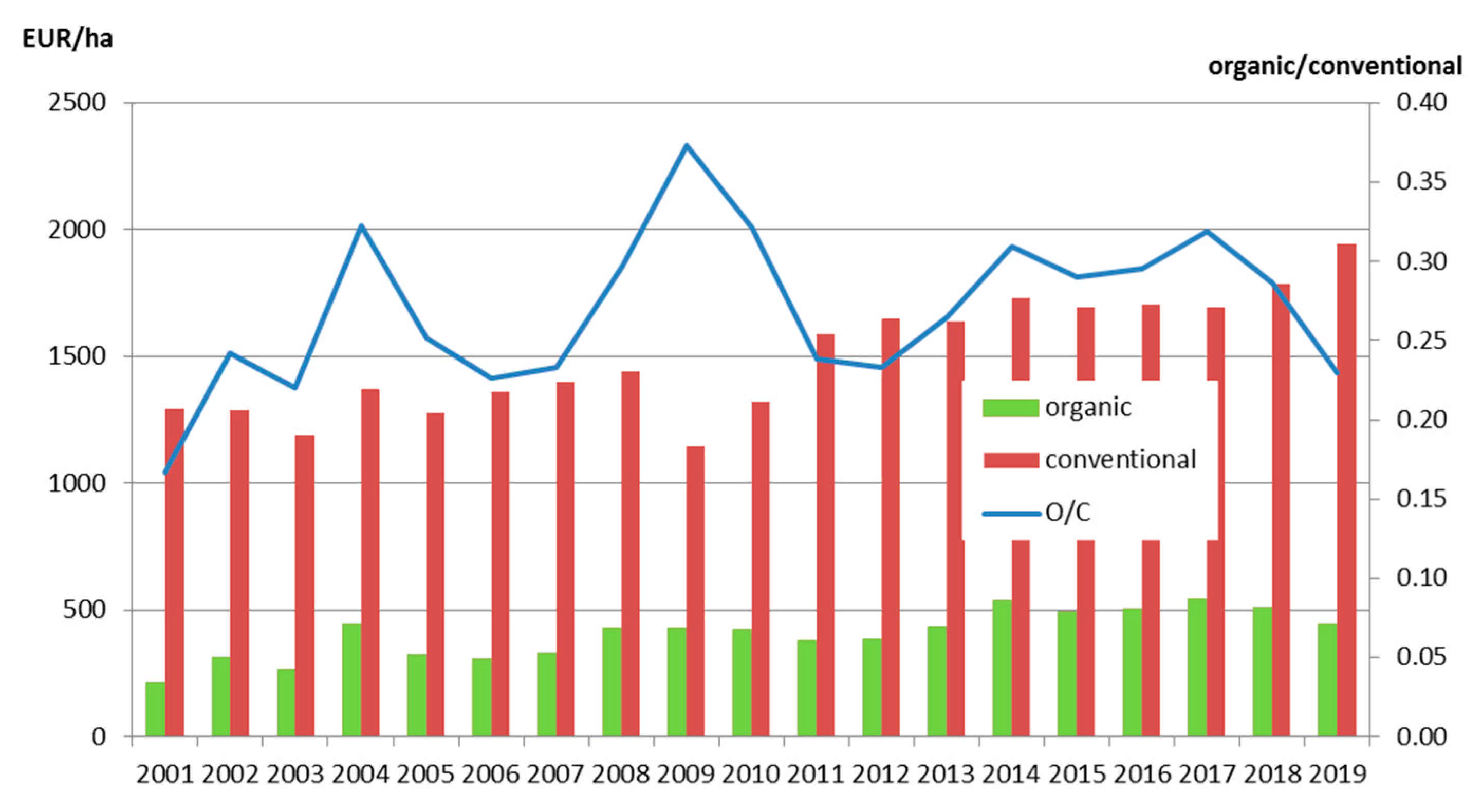

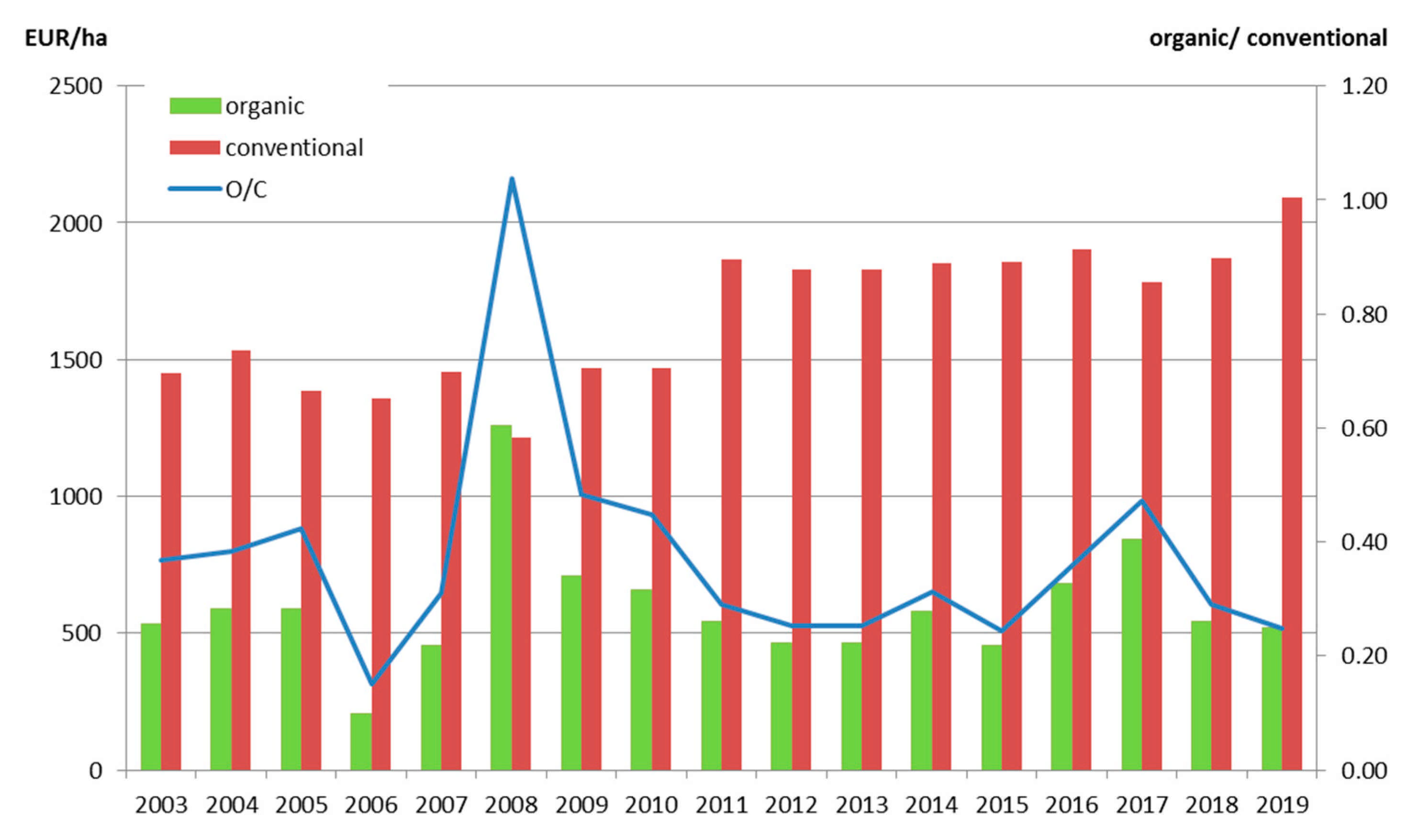

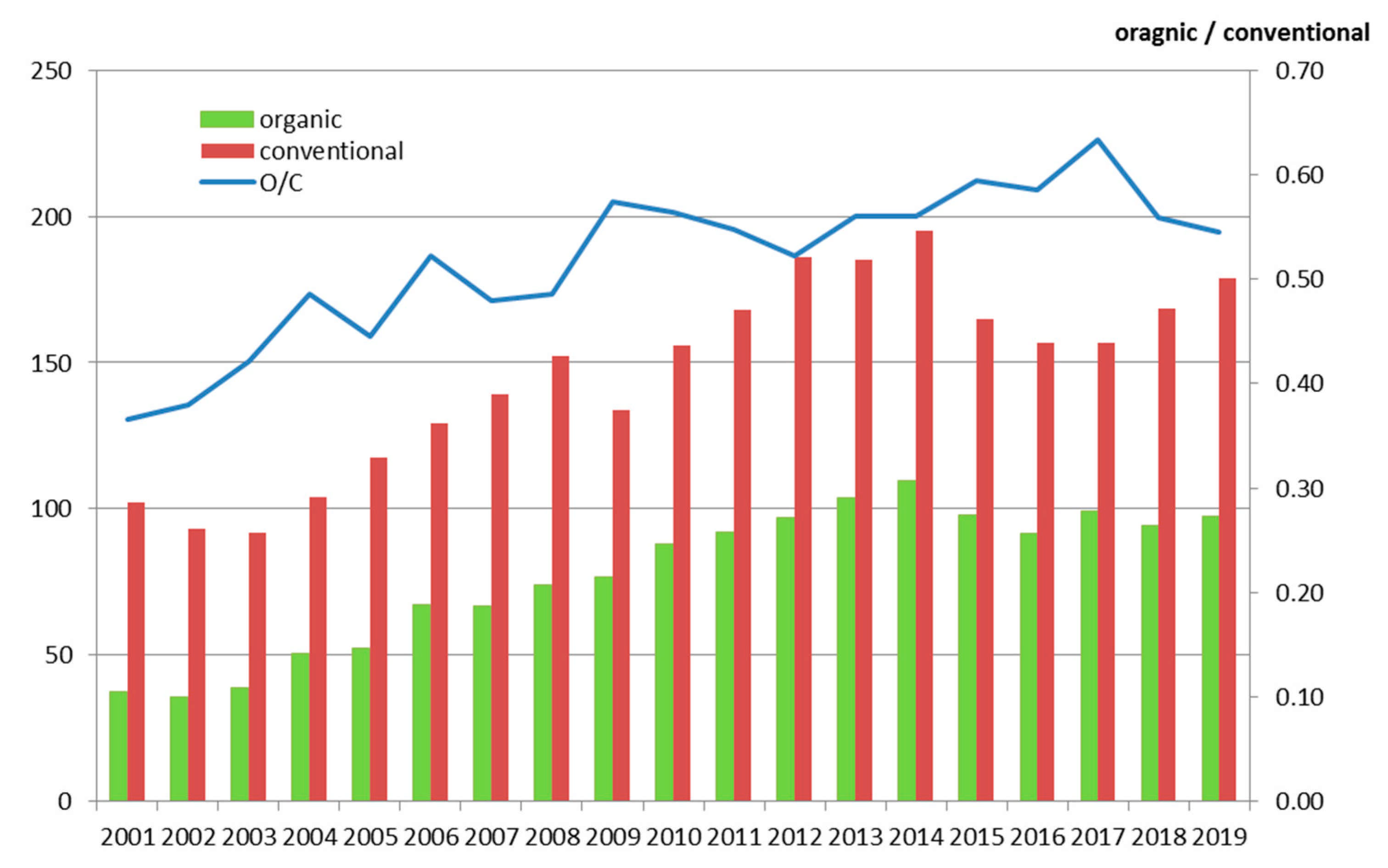
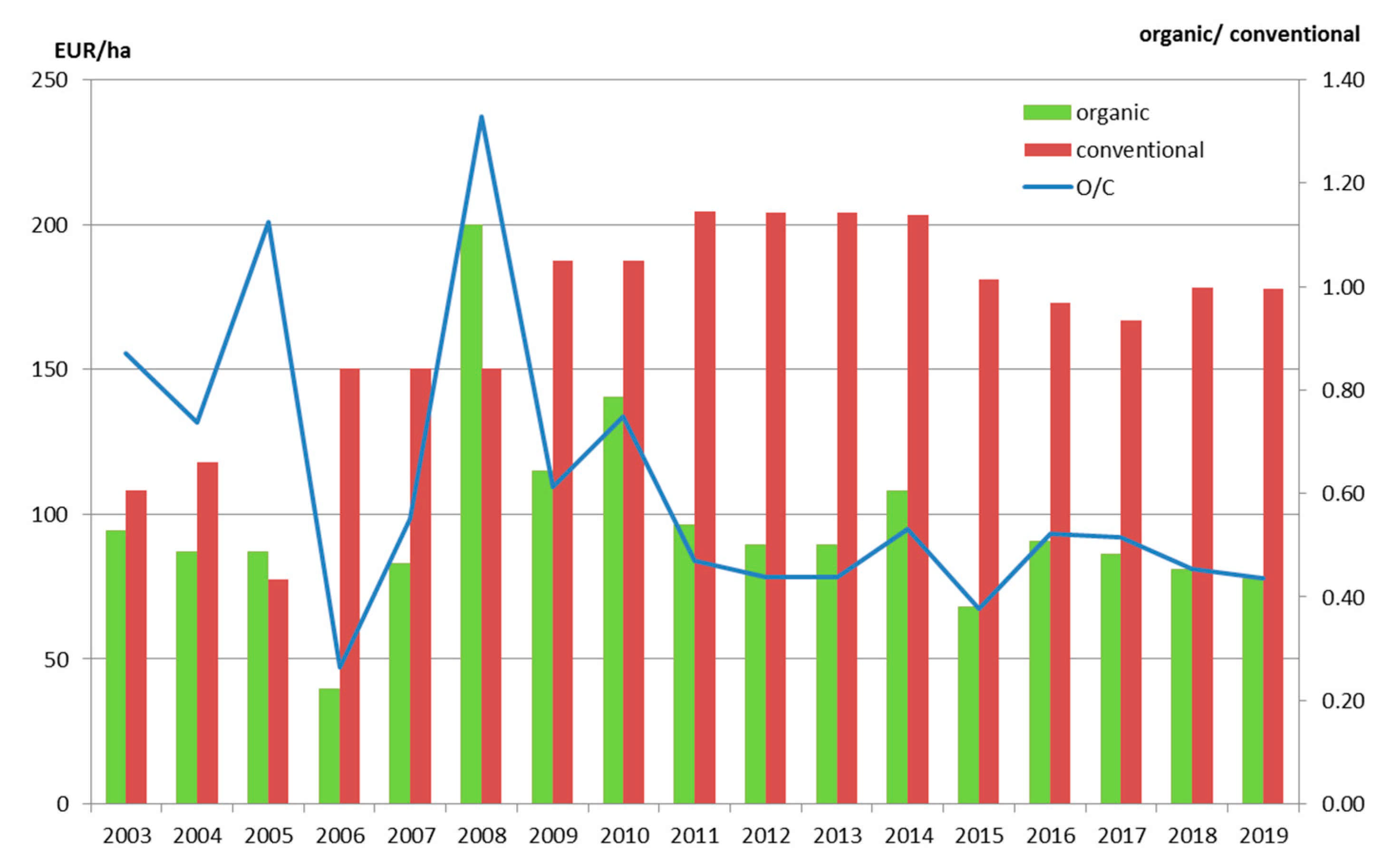
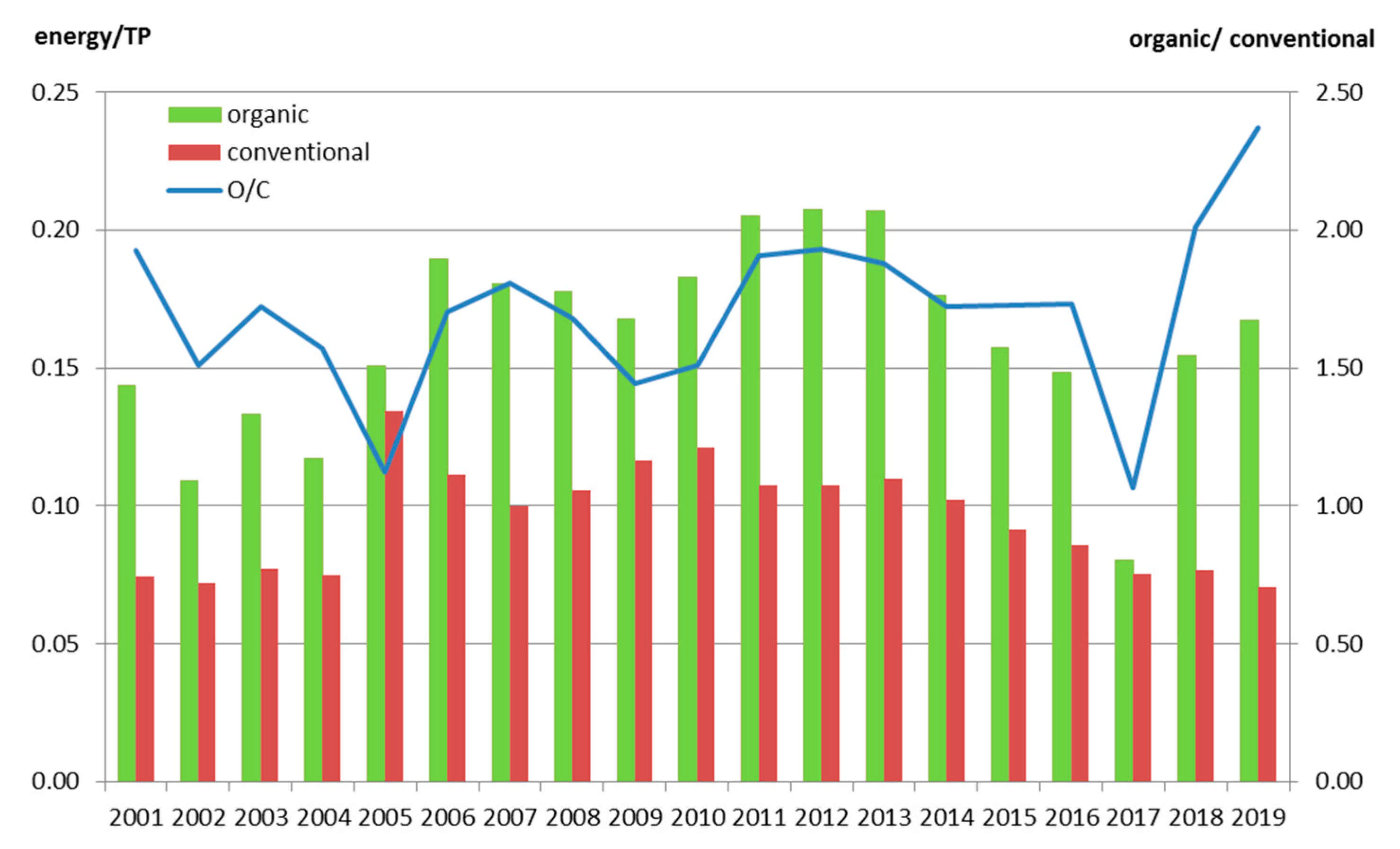

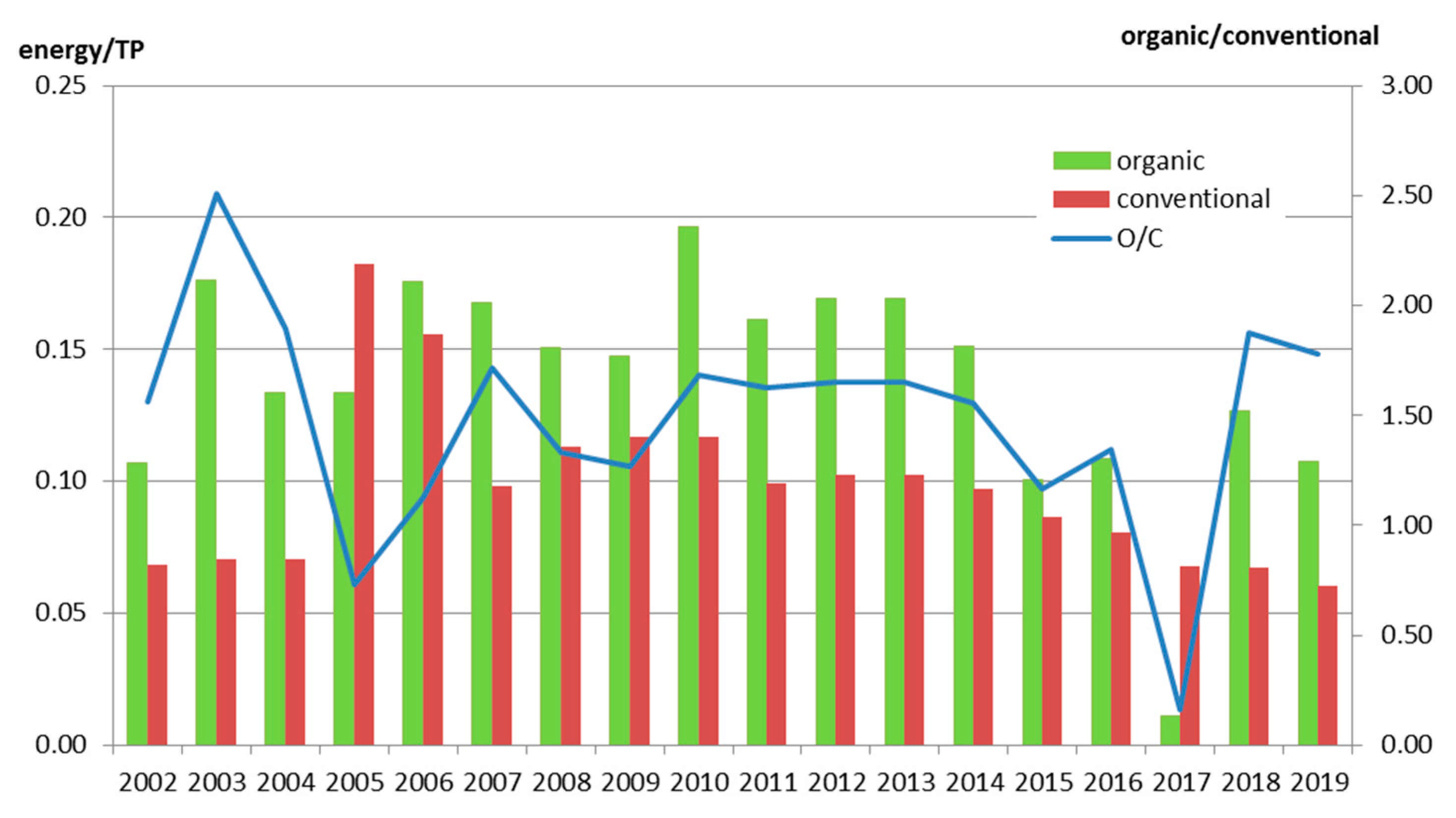
| ANC | Non-ANC | |||||||
|---|---|---|---|---|---|---|---|---|
| OF | CF | OF | CF | |||||
| No. | ha | No. | ha | No. | ha | No. | ha | |
| 2001 | 40 | 18,680 | 695 | 570,366 | 2 | 89 | 544 | 294,305 |
| 2002 | 70 | 24,827 | 773 | 605,781 | 4 | 433 | 631 | 287,397 |
| 2003 | 74 | 23,113 | 789 | 577,753 | 4 | 118 | 700 | 340,454 |
| 2004 | 74 | 24,775 | 668 | 413,081 | 12 | 5898 | 897 | 506,144 |
| 2005 | 77 | 30,275 | 524 | 324,267 | 9 | 2227 | 1017 | 603,623 |
| 2006 | 75 | 29,426 | 462 | 266,252 | 6 | 740 | 1098 | 650,936 |
| 2007 | 76 | 29,418 | 432 | 237,404 | 7 | 527 | 1068 | 652,708 |
| 2008 | 84 | 27,627 | 451 | 266,090 | 17 | 3252 | 1090 | 624,770 |
| 2009 | 89 | 31,416 | 416 | 241,373 | 34 | 4299 | 2156 | 626,141 |
| 2010 | 125 | 39,165 | 471 | 337,221 | 16 | 5647 | 999 | 530,697 |
| 2011 | 223 | 66,267 | 503 | 354,829 | 38 | 2896 | 857 | 452,035 |
| 2012 | 200 | 58,813 | 461 | 334,792 | 32 | 4104 | 740 | 404,595 |
| 2013 | 195 | 53,545 | 449 | 321,100 | 39 | 5016 | 732 | 391,132 |
| 2014 | 187 | 48,430 | 439 | 315,891 | 50 | 4824 | 700 | 409,951 |
| 2015 | 202 | 51,204 | 461 | 331,542 | 43 | 7995 | 701 | 424,046 |
| 2016 | 210 | 56,253 | 471 | 335,512 | 43 | 4442 | 699 | 445,300 |
| 2017 | 220 | 62,266 | 473 | 354,373 | 57 | 5856 | 676 | 460,500 |
| 2018 | 240 | 64,343 | 569 | 402,854 | 38 | 3881 | 607 | 392,994 |
| 2019 | 218 | 54,984 | 538 | 383,815 | 39 | 4007 | 587 | 379,537 |
| Index AP/ha | Index EC/ha | Index EC/AP | |||||||
|---|---|---|---|---|---|---|---|---|---|
| ANC | Non-ANC | Total | ANC | Non-ANC | Total | ANC | Non-ANC | Total | |
| 2001 | 0.18 | x | 0.17 | 0.37 | x | 0.35 | 1.89 | x | 1.93 |
| 2002 | 0.25 | 0.95 | 0.24 | 0.38 | 1.60 | 0.39 | 1.46 | 1.56 | 1.51 |
| 2003 | 0.25 | 0.37 | 0.22 | 0.42 | 0.87 | 0.40 | 1.60 | 2.51 | 1.72 |
| 2004 | 0.27 | 0.38 | 0.32 | 0.49 | 0.74 | 0.52 | 1.61 | 1.90 | 1.57 |
| 2005 | 0.25 | 0.42 | 0.25 | 0.45 | 1.13 | 0.64 | 1.62 | 0.73 | 1.12 |
| 2006 | 0.23 | 0.15 | 0.23 | 0.52 | 0.26 | 0.55 | 2.05 | 1.13 | 1.71 |
| 2007 | 0.26 | 0.31 | 0.23 | 0.48 | 0.55 | 0.46 | 1.70 | 1.71 | 1.81 |
| 2008 | 0.27 | 1.04 | 0.30 | 0.49 | 1.33 | 0.53 | 1.60 | 1.33 | 1.68 |
| 2009 | 0.40 | 0.48 | 0.37 | 0.57 | 0.61 | 0.56 | 1.37 | 1.27 | 1.44 |
| 2010 | 0.37 | 0.45 | 0.32 | 0.56 | 0.75 | 0.52 | 1.41 | 1.68 | 1.51 |
| 2011 | 0.29 | 0.29 | 0.24 | 0.55 | 0.47 | 0.50 | 1.73 | 1.62 | 1.91 |
| 2012 | 0.27 | 0.25 | 0.23 | 0.52 | 0.44 | 0.49 | 1.76 | 1.65 | 1.93 |
| 2013 | 0.31 | 0.25 | 0.26 | 0.56 | 0.44 | 0.52 | 1.73 | 1.65 | 1.88 |
| 2014 | 0.34 | 0.31 | 0.31 | 0.56 | 0.53 | 0.55 | 1.62 | 1.56 | 1.72 |
| 2015 | 0.34 | 0.24 | 0.29 | 0.59 | 0.38 | 0.54 | 1.69 | 1.16 | 1.73 |
| 2016 | 0.34 | 0.36 | 0.30 | 0.59 | 0.52 | 0.55 | 1.62 | 1.35 | 1.73 |
| 2017 | 0.32 | 0.47 | 0.32 | 0.63 | 0.52 | 0.61 | 1.83 | 0.16 | 1.07 |
| 2018 | 0.30 | 0.29 | 0.29 | 0.56 | 0.45 | 0.54 | 1.75 | 1.87 | 2.01 |
| 2019 | 0.26 | 0.25 | 0.23 | 0.54 | 0.44 | 0.51 | 2.05 | 1.78 | 2.37 |
| Index AP/ha | Index EC/ha | Index EC/AP | ||||||||||
|---|---|---|---|---|---|---|---|---|---|---|---|---|
| Cereals | Fruits and Vegetable | Milk Production | Cattle Breeding | Cereals | Fruits and Vegetable | Milk Production | Cattle Breeding | Cereals | Fruits and Vegetable | Milk Production | Cattle Breeding | |
| 2001 | 0.31 | N/A | N/A | 0.17 | 0.38 | N/A | N/A | 0.41 | 1.32 | N/A | N/A | 1.95 |
| 2002 | 0.42 | N/A | 0.59 | 0.41 | 0.32 | N/A | 0.56 | 0.52 | 0.79 | N/A | 1.02 | 1.10 |
| 2003 | N/A | N/A | 0.68 | 0.32 | N/A | N/A | 0.59 | 0.48 | N/A | N/A | 0.89 | 1.39 |
| 2004 | N/A | N/A | 0.66 | 0.27 | N/A | N/A | 0.67 | 0.48 | N/A | N/A | 0.95 | 1.58 |
| 2005 | N/A | N/A | 0.67 | 0.34 | N/A | N/A | 0.74 | 0.53 | N/A | N/A | 1.10 | 1.49 |
| 2006 | N/A | N/A | 0.64 | 0.32 | N/A | N/A | 0.54 | 0.49 | N/A | N/A | 0.67 | 1.42 |
| 2007 | N/A | N/A | 0.51 | 0.31 | N/A | N/A | 0.48 | 0.57 | N/A | N/A | 0.98 | 1.74 |
| 2008 | 0.43 | N/A | 0.58 | 0.26 | 1.15 | N/A | 0.72 | 0.48 | 2.89 | N/A | 1.13 | 2.39 |
| 2009 | N/A | N/A | 0.59 | 0.42 | N/A | N/A | 0.69 | 0.58 | N/A | N/A | 1.21 | 1.27 |
| 2010 | N/A | N/A | 0.82 | 0.40 | N/A | N/A | 0.89 | 0.62 | N/A | N/A | 1.12 | 1.33 |
| 2011 | 0.51 | 0.29 | 0.49 | 0.37 | 1.00 | 0.21 | 0.73 | 0.61 | 2.03 | 0.74 | 1.48 | 1.50 |
| 2012 | N/A | 0.31 | 0.62 | 0.40 | N/A | 0.59 | 0.87 | 0.62 | N/A | 1.88 | 1.34 | 1.40 |
| 2013 | 0.21 | 0.22 | 0.62 | 0.35 | 0.74 | 0.47 | 0.87 | 0.59 | 3.48 | 2.11 | 1.34 | 1.57 |
| 2014 | 0.47 | 0.22 | 0.60 | 0.56 | 0.80 | 0.28 | 0.79 | 0.75 | 1.82 | 1.31 | 1.34 | 1.43 |
| 2015 | 0.87 | 0.32 | 0.63 | 0.41 | 1.39 | 0.36 | 0.80 | 0.67 | 1.67 | 0.83 | 1.21 | 1.50 |
| 2016 | 0.70 | 0.33 | 0.71 | 0.54 | 1.46 | 0.42 | 0.80 | 0.74 | 2.25 | 1.09 | 1.20 | 1.20 |
| 2017 | 0.65 | 0.40 | 0.57 | 0.58 | 1.03 | 0.39 | 0.70 | 0.76 | 1.39 | 1.02 | 1.22 | 1.30 |
| 2018 | 0.69 | 0.33 | 0.60 | 0.53 | 1.37 | 0.38 | 0.73 | 0.71 | 2.20 | 1.03 | 1.21 | 1.36 |
| 2019 | 0.59 | 0.46 | 0.58 | 0.48 | 1.03 | 0.34 | 0.68 | 0.66 | 1.84 | 0.74 | 1.22 | 1.24 |
Publisher’s Note: MDPI stays neutral with regard to jurisdictional claims in published maps and institutional affiliations. |
© 2021 by the authors. Licensee MDPI, Basel, Switzerland. This article is an open access article distributed under the terms and conditions of the Creative Commons Attribution (CC BY) license (https://creativecommons.org/licenses/by/4.0/).
Share and Cite
Redlichová, R.; Chmelíková, G.; Blažková, I.; Svobodová, E.; Vanderpuje, I.N. Organic Food Needs More Land and Direct Energy to Be Produced Compared to Food from Conventional Farming: Empirical Evidence from the Czech Republic. Agriculture 2021, 11, 813. https://doi.org/10.3390/agriculture11090813
Redlichová R, Chmelíková G, Blažková I, Svobodová E, Vanderpuje IN. Organic Food Needs More Land and Direct Energy to Be Produced Compared to Food from Conventional Farming: Empirical Evidence from the Czech Republic. Agriculture. 2021; 11(9):813. https://doi.org/10.3390/agriculture11090813
Chicago/Turabian StyleRedlichová, Radka, Gabriela Chmelíková, Ivana Blažková, Eliška Svobodová, and Inez Naaki Vanderpuje. 2021. "Organic Food Needs More Land and Direct Energy to Be Produced Compared to Food from Conventional Farming: Empirical Evidence from the Czech Republic" Agriculture 11, no. 9: 813. https://doi.org/10.3390/agriculture11090813





